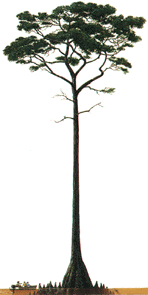 Representative painting of an old-growth tree on the floodplain at Congaree Swamp National Monument, SC (8).
|
Taxodium distichum (Linnaeus) Richard 1810
Common NamesBaldcypress, cypress, swamp cypress.Taxonomic notesSyn: Cupressus disticha Linnaeus 1753 (6). Three varieties, distichum, imbricarium, and mexicanum. Of var. mexicanum, I know nothing at this time, save that it is referred to in (1). It may be a synonym for T. mucronatum.Description"Trees cladoptosic; trunk enlarged basally and often conspicuously buttressed; crown monopodial and conic when young, often becoming irregularly flattopped or deliquescent (branched and so divided that the main axis cannot be determined) with age. Shoot system conspicuously dimorphic, long shoots indeterminate, bearing individually abscising, linear to lanceolate leaves, short shoots determinate, abscising in autumn with their leaves, variable, intergrading, at one extreme pendent to horizontally spreading, bearing decurrent, narrowly linear and laterally divergent leaves in 2 rows, at other extreme strictly ascending to occasionally pendent, bearing short-lanceolate to deltate and tightly appressed leaves. Pollen cones in pendent panicles to ca. 25 cm, 2-3 mm, conspicuous in winter prior to pollination. Seed cones 1.5-4 cm" (6).Varieties distichum and imbricarium are indistinguishable in reproductive characteristics and continuously intergrading in morphologic and phenologic characteristics, although pure populations of the extremes appear morphologically and ecologically distinct. Var. mexicanum is annually cladoptosic (deciduous of short shoots), with determinate short shoots abscising concomitantly with expansion of shoots of the following year. Specimens from juvenile individuals, stump sprouts, fertile branchlets, terminal vegetative branchlets, or late-season growth may not be determinable to variety (6). RangeUSA, Mexico and Guatemala (6), in riparian and wetland habitats.Big TreeThe official "big tree" has a dbh of 521 cm, height of 25 m and crown spread of 26 m, located on Cat Island, LA (5). The specimen with greatest known stem volume is the "Senator" (also called the "Sovereign Cypress"), located in Big Tree Park, Longwood, Florida. This tree has a dbh 344 cm, a height of 35.0 m, and an spproximate stem volume of 119.4 m3. The greatest height I know of is 42.7 m for a tree in Congaree National Monument, South Carolina (7).OldestA crossdated age of 1622 years for specimen BCK 69 from NC collected by Stahle, Cleaveland, and Hehr (Brown 1996). I believe this is from a living tree, collected in the late 1980s or early 1990s.DendrochronologyThe old tree was found in the course of a dendrochronological investigation of Black River Swamp baldcypress groves in North Carolina.EthnobotanyA valuable timber tree. The knees are frequently used for curved members in the construction of wooden boats (2).ObservationsHave seen it at the Black River Swamp in southeast North Carolina (near Moores Creek National Battlefield), where some specimens are up to 130 cm in diameter above a butt swell that extends 3-4 m up the trunk. All the trees in the area have lost their tops in past hurricanes and are, like the neighboring hardwoods, only 20 to 30 m tall, but some specimens have yielded core samples containing over 1600 rings. Old-growth baldcypress forest can also be found in Congaree National Monument, South Carolina; in the Okefenokee Swamp on the Georgia-Florida border; and in various other protected areas.RemarksIts roots form natural crooks, or knees, that extend above the water (2). Of all trees, it has perhaps the greatest known tolerance for flooding; trees planted at Blue River reservoir in Oregon are submerged for several months each year, including about half of the growing season.Baldcypress is the state tree of Louisiana (6). Citations(1) Silba, J. 1986. An international census of the Coniferae. Phytologia memoir no. 8. Corvallis, Or.: H.N. Moldenke and A.L. Moldenke.(2) "Cypress," Encarta 97. (3) Elias, Thomas S. 1987. The complete trees of North America; a field guide and natural history. NY: Gramercy Publ. Co. (4) National Park Service. 1995. Congaree Swamp Official Map and Guide. Washington, DC: U.S. Government Printing Office [Paintings by John Dawson]. (5) American Forests. 1996. The 1996-1997 National Register of Big Trees. Washington, DC: American Forests. (6) Watson, Frank D. at the Flora of North America web page. (7) Telephone communication 14-Nov-1998 from Robert Van Pelt, who measured these trees in November 1998. See also: Prasad, Anantha M. and Louis R. Iverson. 1999. A Climate Change Atlas for 80 Forest Tree Species of the Eastern United States. http://www.fs.fed.us/ne/delaware/atlas/. Delaware, Ohio: USFS Northeastern Research Station. |
back | Taxodium | Cupressaceae | home This page is from the Gymnosperm Database
|